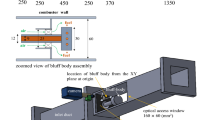Abstract
The improvement of the lean blowout limit of bluffbody stabilized methane flames is investigated. The flame configuration consists of a hybrid of partially and fully premixed flames, which is produced by injecting methane jets from a streamline-shaped bluffbody into a fully premixed methane/air crossflow. Additional geometric modifications from the original bluffbody base are such that the base has two-dimensionally modified geometries and three-dimensional local cavities. We observe that the blowout limit of the hybrid configuration is extended by up to ~12% (in terms of the equivalence ratio of the crossflow) with the modified geometries. Gas chromatographic sampling and particle image velocimetry (PIV) show that high fuel mole fraction regions coexist with regions of low speed flow for the modified geometries. Further PIV analysis shows that the downstream flow fields of the modified bases generally have a larger number of incoherent vortices and lower strain rate in comparison with those of the unmodified base.











Similar content being viewed by others
References
Ballal DR, Lefebvre AH (1979) Weak extinction limits of turbulent flowing mixtures. J Eng Gas Turbine Power 101:343–348
Basu P, Kefa C, Jestin L (2000) Boilers and burners: design and theory. Springer, New York
Cabra R (2003) Turbulent jet flames into a vitiated coflow. PhD dissertation, University of California, Berkeley
Cheng Z, Wehrmeyer JA, Pitz RW (2005) Lean or ultra-lean stretched planar methane/air flames. Proc Combust Inst 30:285–293
Christensen KT, Wu Y (2005) Visualization and characterization of small-scale spanwise vortices in turbulent channel flow. J Visualiz 8:177–185
DeZubay EA (1950) Characteristics of disk-controlled flame. Aero Digest 61:54–57
Esquiva-Dano I, Nguyen HT, Escudie D (2001) Influence of a bluff-body’s shape on the stabilization regime of non-premixed flames. Combust Flame 127:2167–2180
Göttgens J, Mauss F, Peters N (1992) Analytic approximations of burning velocities and flame thicknesses of lean hydrogen, methane, ethylene, ethane, acetylene, and propane flames. Proc Combust Inst 24:129–135
Haynes JM, Feitelberg AS, Burrus DL, Joshi ND (2004) Gas turbine engine combustor can with trapped vortex cavity. US Patent: 6735949
Huelskamp BC, Kiel BV, Lynch AC, Kostka S, Gokulakrishnan P, Klassen MS (2011) Improved correlation for blowout of bluff body stabilized flames. In: 49th AIAA aerospace sciences meeting, AIAA-2011-66, Orlando
Khosla S, Leach TT, Smith CE (2007) Flame stabilization and role of von karman vortex shedding behind bluff body flameholders. In: 43rd AIAA/ASME/SAE/ASEE joint propulsion conference and exhibit, Cincinnati, AIAA-2007-5653, OH
Kiel B, Garwick K, Gord JR, Miller J, Lynch A, Hill R, Phillips S (2007) A detailed investigation of bluff body stabilized flames. In: 45th AIAA aerospace sciences meeting and exhibit, AIAA-2007-168, Reno
Kim W, Im S, Do H, Mungal MG (2010) Flame liftoff height dependence on geometrically modified bluffbodies in a vitiated flow. Exp Fluids 49:27–41
King CR (1957) A semi empirical correlation of afterburner combustion efficiency and lean-blowout fuel-air-ratio with several afterburner inlet variables and afterburner lengths. NACAE57RMF26
Lovett JA, Brogan TP, Philippona DS, Keil BV, Thompson TV (2004) Development needs for advanced afterburner designs. In: 40th AIAA/ASME/SAE/ASEE joint propulsion conferrence and exhibit, AIAA-2004-4192, Fort Lauderdale
Mattingly JD, Heiser WH, Pratt DT (2002) Aircraft engine design. AIAA Inc., Reston
Mullinger P, Jenkins B (2008) Industrial and process furnaces: principles, design and operation. Butterworth-Heinemann, Oxford
Natrajan VK, Christensen KT (2006) The role of coherent structures in subgrid-scale energy transfer within the log layer of wall turbulence. Phys Fluids 18:065104
Nicholson HM, Field JP (1949) Some experimental techniques for the investigation of the mechanism of flame stabilization in the wake of bluff bodies. Proc Combust Inst 3:44–68
Ozawa RI (1970) Survey of basic data on flame stabilization and propagation for high speed combustion systems. US Air Force AFAPL technical report TR-70-81
Potter AE Jr, Wong EL (1958) Effect of pressure and duct geometry on bluff-body flame stabilization. NACA technical note, NACA TN 4381
Rasmussen CC, Driscoll JF (2008) Blowout limits of flames in high-speed airflows: critical Damkohler number. In: 44th AIAA/ASME/SAE/ASEE joint propulsion conference & exhibit, AIAA-2008-4571, Hartford
Sanquer S, Bruel P, Deshaies B (1998) Some specific characteristics of turbulence in the reactive wakes of bluff bodies. AIAA J 6:994–1001
Shanbhogue SJ, Husain S, Lieuwen T (2009) Lean blowoff of bluff body stabilized flames: scaling and dynamics. Prog Energy Combust Sci 35:98–120
Shin DS, Ferziger JH (1991) Linear stability of the reacting mixing layer. AIAA J 29:1634–1642
Stwalley RM, Lefebvre AH (1988) Flame stabilization using large flameholders of irregular shape. J Propuls 4:4–13
Williams GC (1949) Basic studies on flame stabilization. J Aero Sci 16:714–722
Williams GC, Woo PT, Shipman CW (1957) Boundary layers effects on stability characteristics of bluff-body flameholders. Proc Combustion Inst 6:427–438
Zukoski E (1954) Experiments concerning the mechanism of flame blowoff from bluff bodies. PhD thesis, California Institute of Technology
Acknowledgments
This work is sponsored by the AFOSR/STTR Program with Cascade Technologies Inc.—Stability Models for Augmentor Design Tools and Technology Assessment, with Julian Tishkoff as the Technical Monitor. The authors would like to thank Prof. R. Dibble at U.C. Berkeley for providing the premixed burner, Prof. Heinz Pitsch for useful discussion, and M. S. Bak and S.-K. Im for help with the experiments.
Author information
Authors and Affiliations
Corresponding author
Rights and permissions
About this article
Cite this article
Kim, W., Do, H. & Mungal, M.G. The improvement of blowout limit in partially/fully premixed flames with geometrically modified bluffbody bases. Exp Fluids 51, 1315–1328 (2011). https://doi.org/10.1007/s00348-011-1147-6
Received:
Revised:
Accepted:
Published:
Issue Date:
DOI: https://doi.org/10.1007/s00348-011-1147-6




